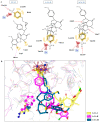Synthesis, Biological and In Silico Studies of Griseofulvin and Usnic Acid Sulfonamide Derivatives as Fungal, Bacterial and Human Carbonic Anhydrase Inhibitors
- PMID: 36769114
- PMCID: PMC9917406
- DOI: 10.3390/ijms24032802
Synthesis, Biological and In Silico Studies of Griseofulvin and Usnic Acid Sulfonamide Derivatives as Fungal, Bacterial and Human Carbonic Anhydrase Inhibitors
Abstract
Carbonic anhydrases (CAs, EC 4.2.1.1) catalyze the essential reaction of CO2 hydration in all living organisms, being actively involved in the regulation of a plethora of patho-/physiological conditions. A series of griseofulvin and usnic acid sulfonamides were synthesized and tested as possible CA inhibitors. Since β- and γ- classes are expressed in microorganisms in addition to the α- class, showing substantial structural differences to the human isoforms they are also interesting as new antiinfective targets with a different mechanism of action for fighting the emerging problem of extensive drug resistance afflicting most countries worldwide. Griseofulvin and usnic acid sulfonamides were synthesized using methods of organic chemistry. Their inhibitory activity, assessed against the cytosolic human isoforms hCA I and hCA II, the transmembrane hCA IX as well as β- and γ-CAs from different bacterial and fungal strains, was evaluated by a stopped-flow CO2 hydrase assay. Several of the investigated derivatives showed interesting inhibition activity towards the cytosolic associate isoforms hCA I and hCA II, as well as the three γ-CAs and Malassezia globosa (MgCA) enzyme. Six compounds (1b-1d, 1h, 1i and 1j) were more potent than AAZ against hCA I while five (1d, 1h, 1i, 1j and 4a) showed better activity than AAZ against the hCA II isoform. Moreover, all compounds appeared to be very potent against MgCA with a Ki lower than that of the reference drug. Furthermore, computational procedures were used to investigate the binding mode of this class of compounds within the active site of human CAs.
Keywords: carbonic anhydrase inhibitors; griseofulvin derivatives; in silico studies; stopped-flow CO2 hydrase assay; usnic acid derivatives.
Conflict of interest statement
The authors declare no conflict of interest.
Figures








Similar articles
-
Pyrazolo[4,3-c]pyridine Sulfonamides as Carbonic Anhydrase Inhibitors: Synthesis, Biological and In Silico Studies.Pharmaceuticals (Basel). 2022 Mar 7;15(3):316. doi: 10.3390/ph15030316. Pharmaceuticals (Basel). 2022. PMID: 35337114 Free PMC article.
-
Chromene-Containing Aromatic Sulfonamides with Carbonic Anhydrase Inhibitory Properties.Int J Mol Sci. 2021 May 11;22(10):5082. doi: 10.3390/ijms22105082. Int J Mol Sci. 2021. PMID: 34064890 Free PMC article.
-
Inhibition of carbonic anhydrase isoforms I, II, IX and XII with secondary sulfonamides incorporating benzothiazole scaffolds.J Enzyme Inhib Med Chem. 2016 Dec;31(6):1306-11. doi: 10.3109/14756366.2015.1128427. Epub 2016 Jan 8. J Enzyme Inhib Med Chem. 2016. PMID: 26745009
-
A Highlight on the Inhibition of Fungal Carbonic Anhydrases as Drug Targets for the Antifungal Armamentarium.Int J Mol Sci. 2021 Apr 21;22(9):4324. doi: 10.3390/ijms22094324. Int J Mol Sci. 2021. PMID: 33919261 Free PMC article. Review.
-
Amino Acids as Building Blocks for Carbonic Anhydrase Inhibitors.Metabolites. 2018 May 24;8(2):36. doi: 10.3390/metabo8020036. Metabolites. 2018. PMID: 29795039 Free PMC article. Review.
Cited by
-
Synthesis and Characterization of a New Class of Chromene-Azo Sulfonamide Hybrids as Promising Anticancer Candidates with the Exploration of Their EGFR, hCAII, and MMP-2 Inhibitors Based on Molecular Docking Assays.Int J Mol Sci. 2023 Nov 24;24(23):16716. doi: 10.3390/ijms242316716. Int J Mol Sci. 2023. PMID: 38069037 Free PMC article.
-
Progress of Section "Biochemistry" in 2022.Int J Mol Sci. 2023 Mar 20;24(6):5873. doi: 10.3390/ijms24065873. Int J Mol Sci. 2023. PMID: 36982946 Free PMC article.
-
Phenyltriazole-based sulfonamides: novel dual-target agents against MRSA biofilms and resistant pathogens.RSC Adv. 2025 Jun 17;15(22):17186-17202. doi: 10.1039/d5ra02412a. eCollection 2025 May 21. RSC Adv. 2025. PMID: 40529822 Free PMC article.
-
Fungal-Bacterial Combinations in Plant Health under Stress: Physiological and Biochemical Characteristics of the Filamentous Fungus Serendipita indica and the Actinobacterium Zhihengliuella sp. ISTPL4 under In Vitro Arsenic Stress.Microorganisms. 2024 Feb 17;12(2):405. doi: 10.3390/microorganisms12020405. Microorganisms. 2024. PMID: 38399809 Free PMC article.
References
-
- Supuran C.T., McKenna R. Carbonic anhydrase inhibitors drug design. In: McKenna R., Frost S., editors. Carbonic Anhydrase: Mechanism, Regulation, Links to Disease, and Industrial Applications. Springer; Berlin/Heidelberg, Germany: 2014. pp. 291–323. - PubMed
-
- Pacchiano F., Carta F., McDonald P.C., Lou Y., Vullo D., Scozzafava A., Dedhar S., Supuran C.T. Ureido-substituted benzenesulfonamides potently inhibit carbonic anhydrase IX and show antimetastatic activity in a model of breast cancer metastasis. J. Med. Chem. 2011;54:1896–1902. doi: 10.1021/jm101541x. - DOI - PubMed
MeSH terms
Substances
LinkOut - more resources
Full Text Sources
Miscellaneous

